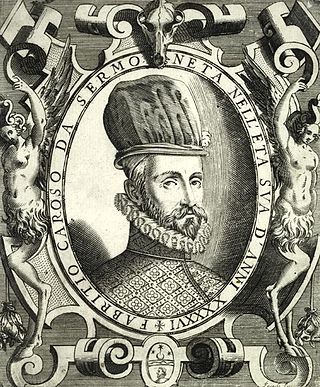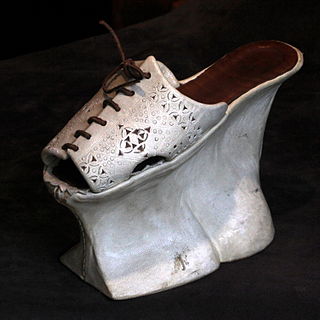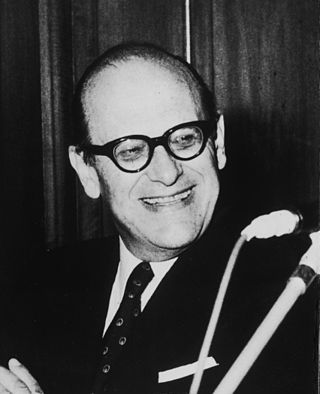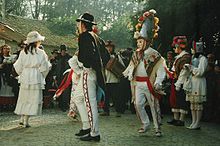
Fabritio Caroso da Sermoneta was an Italian Renaissance dancing master and a composer or transcriber of dance music.

Giovanni Boccaccio was an Italian writer, poet, correspondent of Petrarch, and an important Renaissance humanist. Born in the town of Certaldo, he became so well known as a writer that he was sometimes simply known as "the Certaldese" and one of the most important figures in the European literary panorama of the fourteenth century. Some scholars define him as the greatest European prose writer of his time, a versatile writer who amalgamated different literary trends and genres, making them converge in original works, thanks to a creative activity exercised under the banner of experimentalism.

Sources for an understanding of dance in Europe in the Middle Ages are limited and fragmentary, being composed of some interesting depictions in paintings and illuminations, a few musical examples of what may be dances, and scattered allusions in literary texts. The first detailed descriptions of dancing only date from 1451 in Italy, which is after the start of the Renaissance in Western Europe.
Tarantella is a group of various southern Italian folk dances originating in the regions of Calabria, Campania and Puglia. It is characterized by a fast upbeat tempo, usually in 6
8 time, accompanied by tambourines. It is among the most recognized forms of traditional southern Italian music. The specific dance-name varies with every region, for instance Sonu a ballu in Calabria, tammurriata in Campania, and pizzica in Salento. Tarantella is popular in Southern Italy, Greece, Malta, and Argentina. The term may appear as tarantello in a linguistically masculine construction.

Circle dance, or chain dance, is a style of social dance done in a circle, semicircle or a curved line to musical accompaniment, such as rhythm instruments and singing, and is a type of dance where anyone can join in without the need of partners. Unlike line dancing, circle dancers are in physical contact with each other; the connection is made by hand-to-hand, finger-to-finger or hands-on-shoulders, where they follow the leader around the dance floor. Ranging from gentle to energetic, the dance can be an uplifting group experience or part of a meditation.

Historical dance is a term covering a wide variety of Western European-based dance types from the past as they are danced in the present. Today historical dances are danced as performance, for pleasure at themed balls or dance clubs, as historical reenactment, or for musicological or historical research.

The saltarello is a musical dance originally from Italy. The first mention of it is in Add MS 29987, a late-fourteenth- or early fifteenth-century manuscript of Tuscan origin, now in the British Library. It was usually played in a fast triple meter and is named for its peculiar leaping step, after the Italian verb saltare. This characteristic is also the basis of the German name Hoppertanz or Hupfertanz ; other names include the French pas de Brabant and the Spanish alta or alta danza.
Calandrino is a character from Giovanni Boccaccio's the Decameron, in which he appears in four stories. In these tales he is the victim of the pranks of Bruno and Buffalmacco. He becomes a recurring character in Renaissance literature, especially in Italy.
Italian music terminology consists of words and phrases used in the discussion of the music of Italy. Some Italian music terms are derived from the common Italian language. Others come from Spanish, or Neapolitan, Sicilian, Sardinian or other regional languages of Italy. The terms listed here describe a genre, song form, dance, instrument, style, quality of music, technique or other important aspect of Italian music.

A chopine is a type of women's platform shoe that was popular in the 15th, 16th and 17th centuries. Chopines were originally used as a patten, clog, or overshoe to protect the shoes and dress from mud and street soil.

The Decameron is a 1971 anthology film written and directed by Pier Paolo Pasolini, based on the 14th-century allegory by Giovanni Boccaccio. It is the first film of Pasolini's Trilogy of Life, the others being The Canterbury Tales and Arabian Nights. Each film was an adaptation of a different piece of classical literature focusing on ribald and often irreligious themes. The tales contain abundant nudity, sex, slapstick and scatological humour.

Moresca (Italian), morisca (Spanish), mourisca (Portuguese) or moresque, mauresque (French), also known in French as the danse des bouffons, is a dance of exotic character encountered in Europe in the Renaissance period. This dance usually took form of medieval wars in Spain between Moors and Christians. Elements of moresca include blackening of the face, bells attached to the costumes and, in occasions, men disguised as women to portray fools. An example of the moresca can be seen in Franco Zeffirelli's 1968 production of Romeo and Juliet, which has a scene with both Juliet and Romeo dancing the moresca in a circle.

The Decameron, subtitled Prince Galehaut and sometimes nicknamed l'Umana commedia, is a collection of short stories by the 14th-century Italian author Giovanni Boccaccio (1313–1375). The book is structured as a frame story containing 100 tales told by a group of seven young women and three young men; they shelter in a secluded villa just outside Florence in order to escape the Black Death, which was afflicting the city. Boccaccio probably conceived of the Decameron after the epidemic of 1348, and completed it by 1353. The various tales of love in The Decameron range from the erotic to the tragic. Tales of wit, practical jokes, and life lessons contribute to the mosaic. In addition to its literary value and widespread influence, it provides a document of life at the time. Written in the vernacular of the Florentine language, it is considered a masterpiece of early Italian prose.
Ancient Airs and Dances is a set of three orchestral suites by Italian composer Ottorino Respighi, freely transcribed from original pieces for lute. In addition to being a renowned composer and conductor, Respighi was also a notable musicologist. His interest in music of the Renaissance and Baroque periods led him to compose works inspired by the music of these periods.
Croatian dance traditionally refers to a category of folk-dances, the most common being the kolo.
Julia Sutton was a musicologist and historian of early dance and music. She was professor at New England Conservatory of Music, teaching in the Music History and Musicology department, which she chaired for more than twenty years. She also taught in NEC's Performance of Early Music department, and directed the Collegium Terpsichore. Sutton was active in the founding of the Society of Dance History Scholars. She received her PhD from Rochester University's Eastman School of Music in 1962.

Folklore of Italy refers to the folklore and urban legends of Italy. Within the Italian territory, various peoples have followed one another over time, each of which has left its mark on current culture. Some tales also come from Christianization, especially those concerning demons, which are sometimes recognized by Christian demonology. Italian folklore also includes the genre of the fairy tale, folk music, folk dance and folk heroes.
European dances refers to various dances originating in Europe. Since Medieval ages, many European dances tend to be refined, as some are based on the court dances of aristocrats.

Vittore Branca was a philologist, literary critic, and Italian academic. He was a professor emeritus of Italian literature at the University of Padua until his death in 2004, and one of the most acclaimed contemporary scholars of Italian author and poet Giovanni Boccaccio.

Alessandra Belloni is an Italian musician, singer, dancer, actress, choreographer, teacher, and ethnomusicologist. Her instrument is the Southern Italian tambourine and her music and dance are focused on the traditional roots of tarantella. Her studies of tarantism are rooted in the culture of Apulia and Calabria, expressing it from women's point of view. Her work has gained international appreciation, especially in the United States and Brazil. She is artist in residence at the Cathedral of St. John the Divine.

























